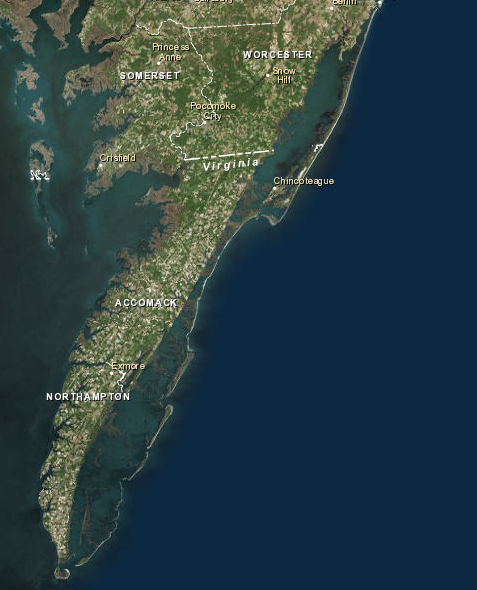What's a Barrier Island?

Eastern Shore Virginia via Nasa LandSat
Barrier Islands can be seen off the mainland.
Northampton County's barrier islands are among its most important and unique natural resources. For centuries, they played a major role in the history, economy, and culture of the area. Although there once were small fishing villages and hunting lodges on the islands, today they are uninhabited. Most of the islands are included in the Virginia Coast Reserve, which is an island and salt marsh preserve owned by The Nature Conservancy of Arlington, Virginia. The Virginia Coast Reserve has been designated an International Biosphere Reserve by the United Nations in recognition of the importance and fragility of the ecosystem. Northampton County's islands, together with contiguous islands in neighboring Accomack County, represent the last undeveloped barrier island system on the Atlantic Coast.
There are twelve barrier islands in Northampton County. Hog, Rogue, Cobb, Little Cobb, Ship Shoal, Godwin, Myrtle, Mink, and Smith Islands are mostly owned by The Nature Conservancy. 
The Commonwealth of Virginia owns Mockhorn and Wreck Islands. Fisherman’s Island, on the tip of the peninsula, is owned by the Federal government and is part of the Eastern Shore National Wildlife Refuge. The Nature Conservancy has specific rules regarding the use of the islands they own. Most of the islands are open to the public for low-impact, non-commercial, recreational day use (hiking, bird watching and fishing). Motorized vehicles, pets, and overnight camping activities are prohibited. There are also seasonal restrictions to protect nesting birds.
The barrier islands play a number of important roles in Northampton County including: protection from storms as buffers to dissipate the energy of the ocean; economic benefits including commercial and recreational fishing; recreation including fishing, hunting, crabbing, clamming, hiking, boating, and bird watching; and nature study as an educational resource, increasing awareness of the importance and rarity of the island system, and protection of threatened species, offering sanctuary to many species of birds, mammals, and reptiles that are threatened or endangered.
The islands are dynamic in nature; migrating westward over the past 160 years. Because the Virginia Coast Reserve is gaining national and international attention as one of America's last remaining intact barrier island systems, Northampton County benefits through research and educational programs centered around the island system. The University of Virginia has established a National Science Foundation Long Term Ecological Research Center in Northampton County and established its headquarters in the Village of Oyster. Most of the barrier islands are included either in the Virginia Coast Reserve, the Federal National Wildlife System, or the Virginia Natural Areas Program, but even limited development on any of the islands would drastically alter the system scientifically and aesthetically.
In managing the barrier island system, biological diversity has been the priority. It is important to recognize that the island system functions as an interdependent whole. The system includes related natural communities of beaches, dunes, upland forest, extensive salt marshes, bays, creeks, guts, unvegetated wetlands, mainland salt marshes, and any seaside mainland which is part of the watershed.
Source: Northampton County Comprehensive Plan Part II Chapter 4,5,6 Revisions per 9-5-18 meeting